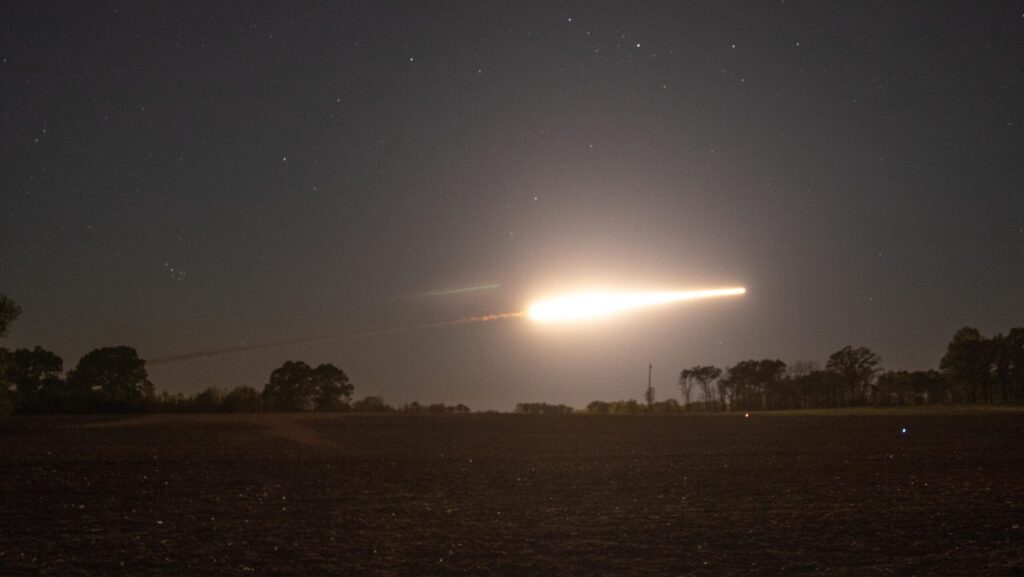A High Mobility Artillery Rocket Systems (HIMARS) from Alpha “Able” Battery, 3-321st Field Artillery Regiment (FAR) from the 18th Field Artillery Brigade (FAB) lights up the night sky on Fort Campbell, Ky., during a Large-Scale, Long-Range Air Assault as part of Operation Lethal Eagle 24.1, April 24, 2024. (Photo by Sgt. 1st Class Joshua Tverberg)
Precision munitions have given the United States a decisive combat edge for 50 years. From Desert Storm to the invasions of Iraq and Afghanistan, “one bomb, one kill” has become the expectation. As the United States passed this capability to Ukraine for its struggle with Russia, HIMARS with GMLRS, Excalibur 155 mm artillery shells, Ground-Launched Small-Diameter Bombs, and JDAMs have had an immense impact on the battlefield.
Yet, Russia has used electronic warfare, decoys, deception, and dispersion to render some useless. And that raises a potentially destabilizing question for the US military: What if precision location and guidance are losing their battlefield dominance in the face of countermeasures? If so, the United States will need to change its concepts of operations and acquisition strategies to hedge against the possibility of operations with diminished location capabilities.
DoD defines a precision munition as “a guided weapon intended to destroy a point target and minimize collateral damage.” Precision also includes the entire range of command and control capabilities arising from automated and accurate geolocation. The focus on precision permeates guidance and doctrinal publications across the services. Outside DoD, study after study has proposed that the US expand long-range precision munitions to stay outside of adversary defensive zones. Given precision’s centrality, any failure of precision guidance and geolocation on future battlefields would be disastrous for US operations.
Countermeasures to precision munitions are not new. Precision munitions might be accurate, but they must be told where to go. Adversaries long ago realized that hiding and dispersion provided a first level of protection. But facilities can’t be moved, meaning those are easy targets for precision weapons, and as seen in both Iraq conflicts, battlefield geography does not always allow an enemy force to hide. Thus, precision remained immensely effective, even if its ability to strike mobile or concealed targets was limited.
RELATED: Taking aim: Army leaders ponder mix of precision munitions vs conventional
The countermeasures now being seen in Ukraine, however, represent a leap forward. Where Iraq or Serbia had a hard time countering the apex of Western technology, Russia had been preparing to do that for decades. Further, Russia, China, and virtually every country on the planet has watched what the United States has done to its adversaries and thought about ways to blunt those attacks should US firepower be sent in their direction.
As a result, the Russians have had great success with jamming GPS signals (interfering with them so they can’t get through) and spoofing (distorting the signals so they are inaccurate). Excalibur, the precision artillery projectile, is not used anymore because its effectiveness declined below 10 percent for a munition costing $160,000 each. Similarly, JDAMs and Ground Launched Small Diameter Bomb (GLSDB) have become largely ineffective. GMLRS is struggling. That’s a major part of the US short and medium-range precision munitions, apparently rendered ineffective.
Not only are weapons affected but tracking systems have also become unreliable. For example, pilots flying near war zones find that locations in their navigation systems are scrambled and so unreliable that they turn GPS off.
The evolution of countermeasures is not surprising — there are multiple examples from both World Wars of one side making a move and the other responding. But the fact countermeasures were made does not mean the US can afford not to react. Delays are paid for in blood. Before a catastrophic wartime failure, the United States needs to implement a hedging strategy in peacetime.
One element of such a strategy would be improving munition guidance to overcome or avoid jamming. Another would be acquiring alternative kinds of munitions to cope with diminished precision. A final element would be training personnel to adapt to the environment.
RELATED: In Paris, military leaders weigh in on mass fires vs. precision fires
GPS improvements. The defense industry has devised ways to reduce the effectiveness of jamming and spoofing, and the DoD is racing to implement them. There are special processors, antennas and signal processors to read distorted or weak signals, and there are no doubt also classified programs. With time, the most effective improvements will become ubiquitous on the battlefield. Postwar assessments of operations in Ukraine will help identify these.
Nevertheless, there are limits. At best, GPS signals are weak — the satellite is 23,000 miles away in a geosynchronous orbit. Further, not all munitions can accommodate all improvements. Artillery shells, for example, have severe limits on antennae and space.
Luckily, US GPS is not the only way to guide munitions. While none of the alternatives are as cheap or effective as GPS, they do exist. Among the options:
Multiple GPS receivers on the munition, linking not just to the US GPS satellite constellation but to those of other countries, would be possible. The Russians have GLONASS, the Chinese have BeiDou (BDS), and the European Union has Galileo. Indeed, some cell phones already link to multiple geolocation networks. Because these are just receivers and not transmitters, they don’t have the security issues that using a Chinese 5G network does.Although all these constellations are susceptible to jamming, adversaries might be reluctant to shut them all down, including their own. For example, if the Chinese shut down their own system to thwart US munitions, they would badly disrupt their economy and civil society.
Inertial navigation systems (INS) have sensitive sensors (accelerometers and gyroscopes) that measure acceleration and direction. That data and a known starting point allow INS to determine where it is and where it needs to go. Although immune to jamming, inertial navigation is less accurate than GPS and much more expensive. It is unsuitable for artillery shells, which sustain immense acceleration forces (16,000g) when fired.
Terrain contour matching uses sensors on the missile to identify the terrain it is flying over. It then compares that with the terrain map in its memory, using that map to navigate to the target. Terrain contour matching is more accurate than inertial navigation because it provides terminal navigation. However, it is costly and only suitable for large, long-range missiles where the extra weight and expense are not a significant problem. For example, Tomahawk missiles include this system, alongside GPS.
Laser guidance uses a spotter to illuminate the target; the munition sees the laser and guides on it. Many of the early precision-guided munitions had such guidance. It’s effective and hard to jam but has one huge drawback: Spotters must be close to the target. For aircraft, that means getting deep inside the adversary’s defensive zone. On the ground, it requires a clear view of the target and close coordination with the shooter. The United States had a laser-guided artillery munition called Copperhead, but it was rarely used because of the coordination challenges.
Alternative munitions: If precision weapons are to be challenged, then the simplest answer may be to increase procurement for non-precision weapons.
Cluster munitions were the backbone of artillery and rocket firepower in the 1980s and into the 1990s. By spreading their explosive force over a wide area, they were much more effective than regular artillery projectiles, seven times as effective in battlefield analyses and up to 40 times as effective in tests. However, the high dud rate of bomblets led to restrictions by most global powers. The United States kept such munitions for emergencies and fielded “unitary” munitions as a replacement. Rather than spreading bomblets over a wide area, the unitary munition concentrates its explosive power in one spot. Precision guidance coupled with great improvements in target location allowed the point of impact to be directly over the target, so there was no loss of effectiveness against point targets. (There was for area targets, which are spread out, but that was accepted.)
The problem arises when guidance fails. Then, the unitary impact might not be close enough to the target to cause damage, but cluster munitions would still have an effect. Their area impact makes them resilient to a lack of precision.
For MLRS rockets, the Army has devised an alternative warhead that fires 160,000 tungsten pellets, creating a shotgun effect and replicating the effects of cluster munitions. That might be an attractive modification for some munitions, but the approach may not be technically viable for artillery shells because of their smaller size.
Another option is to use sheer mass. An astonishing outcome of the war in Ukraine has been the importance of unguided artillery munitions. Ukraine and Russia have an insatiable desire for artillery ammunition, with combined expenditures likely reaching half a million a month during intense combat.
The US Army is hedging its bets on mass and precision. As its operations field manual states, “Leaders generate firepower through direct and indirect fires, using mass, precision, or, typically, a combination of the two.” Thus, the Army is pursuing a variety of precision attack programs from the Precision Strike Missile to hypersonics. The Army is also increasing its production of “dumb” artillery shells by a factor of six, from a prewar level of 14,000 per month to 100,000 per month by 2025. It retains the artillery force structure to deliver a high volume of fires.
In contrast, the Marine Corps has emphatically rejected any reliance on mass and bet on long-range precision attack. It has eliminated most of its cannon artillery and about one-third of its airpower. Instead, it is standing up three long-range Tomahawk batteries and 14 anti-ship missile batteries.
Training and expectations. The US military depends on geolocation systems not just for munitions and firepower but also for location and coordination. As adversary countermeasures affect precision munitions, they also affect the ability of friendly forces to know where they are. By tracking friendly, neutral, and enemy forces, command and control systems enhance maneuver and reduce fratricide. They also allow individuals and units to continuously know where they are, even in the most challenging terrain.
During the regional and counterinsurgency conflicts of the last 25 years, the US military has become spoiled by its superb knowledge of the battlefield. If these automated systems go down, troops will need to revert to manual or stand-alone graphical systems. These are not technically difficult but take much practice to be effective at scale. Even simple tasks like navigating with a map require training and practice. These skills have atrophied in the military and need to be rediscovered as backups in case electronic systems become unreliable.
An evolution, not a revolution. A thought experiment is worthwhile. In 2022, CSIS ran a series of wargames that analyzed a US-Chinese conflict over Taiwan. The United States and its coalition partners could maintain an autonomous and democratic Taiwan, though at a high cost. The coalition could do that because of its large numbers of long-range precision munitions, particularly anti-ship munitions. The Chinese fleet, tethered to Taiwan because of the need to support amphibious forces, was decimated by these missile attacks. If something happened to make these missile attacks significantly less effective, then the outcome of the conflict would change dramatically, unexpectedly, and rapidly.
Precision is not going to disappear from the battlefield. No countermeasure will completely neutralize geolocation systems, and for every countermeasure, there will be a counter–countermeasure. Further, only the most sophisticated opponents can field the full array of countermeasures and keep up in a measure/countermeasure competition; Israel, for example, has not reported significant disruption in its precision attacks against Hamas. Nevertheless, every future competition will have some counter-precision capability, and operations in a great power conflict against China or Russia will face extreme countermeasures.
Thus, DoD needs to move forward with the hedges described above. The consequences of being surprised by reduced effectiveness would be devastating.
Mark Cancian is a retired Marine colonel now with the Center for Strategic and International Studies (CSIS).











